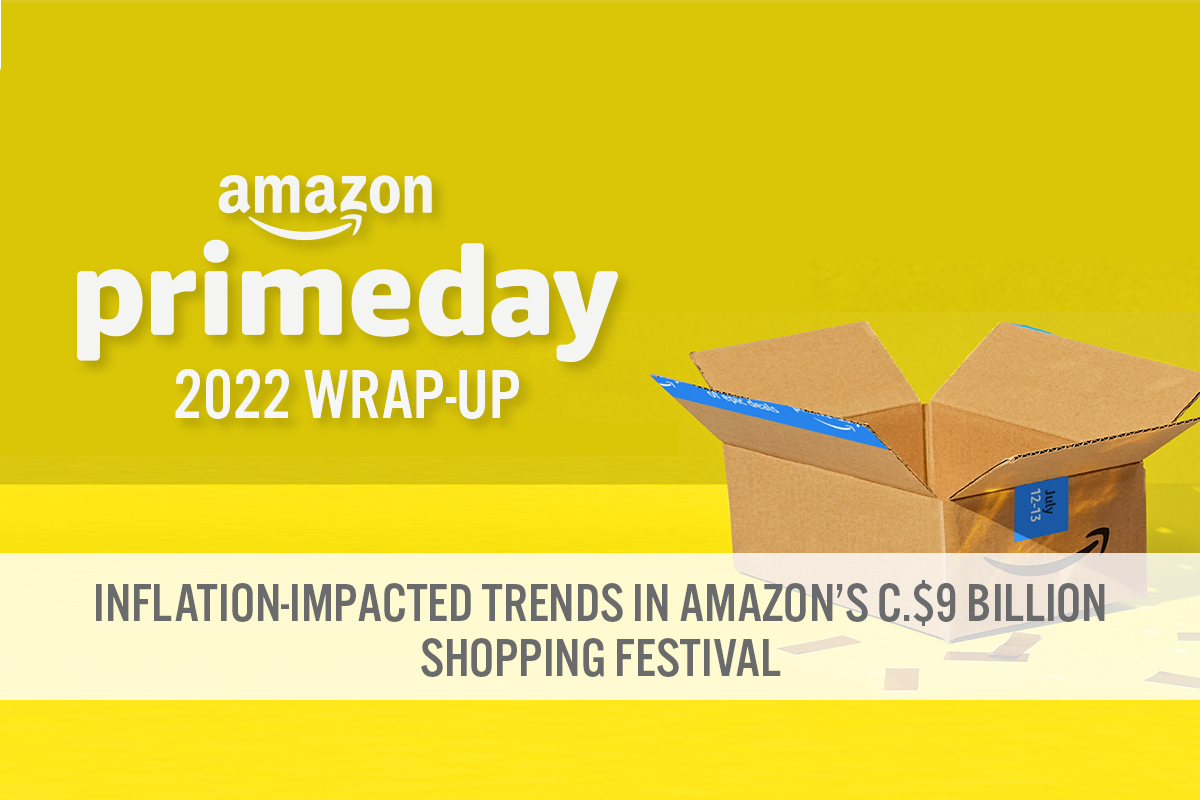
albert Chan
Introduction
What’s the Story?
On July 14, 2022, Amazon released selected metrics for its Prime Day 2022 event, which was held on July 12–13 in 20 markets globally, including the US. Based on these metrics and our observations of the event, we present insights into the size of Prime Day 2022 and key trends.
Why It Matters
This year, Prime Day came at an uncertain time, clouded by inflation and supply chain disruption. An analysis of Amazon’s early metrics for the event offers some indication into consumer sentiment and the health of the retail sector in general.
Amazon Prime Day 2022: Coresight Research Analysis
How Big Is Prime Day?
This year, Amazon’s Prime Day extended to 20 markets: Austria, Australia, Belgium, Brazil, Canada, China, France, Germany, Italy, Japan, Luxembourg, Mexico, the Netherlands, Portugal, Singapore, Spain, the UK, the US and, for the first time, Poland and Sweden. (India’s Prime Day is a separate event that will be held on July 23–24 this year).
Amazon Prime members purchased more than 300 million items during the event, up from around 250 million in 2021, making the eighth annual Prime Day the biggest yet, according to Amazon.
Based on management commentary after Prime Day 2021, we estimate that last year’s 48-hour event saw Amazon generate around $8 billion in global GMV. Based on company reports so far, we do not have a firm indication of the GMV generated during this year’s event. However, our initial estimate is that Amazon generated total, worldwide GMV of approximately $8.6–9.6 billion across the 48 hours of Prime Day 2022:
- Amazon’s post-Prime Day 2022 press release implies an average unit price of around $30 (based on small-business sales). Meanwhile, last year’s estimated GMV implies an approximate $32 average unit price, based on 250 million items sold during 2021’s event. Extrapolating a $30–$32 average unit price to the number of sales per minute (shown in Figure 1) implies total, worldwide Amazon GMV of approximately $8.6–9.2 billion.
- Alternatively, extrapolating from 2021’s estimated $8 billion GMV and reported unit sales of 250 million, and 2022’s reported 300 million unit sales, implies 2022 GMV of approximately $9.6 billion.
- In turn, the 60/40 split indicated by the US/international unit sales in Figure 1 imply Amazon US-only GMV of between $5.2 billion and $5.8 billion this year. We believe this magnitude aligns with data reported by Adobe, of $11.9 billion in total US online retail sales over the two days of Prime Day.
The most popular products during Prime Day 2022 were electronics (including Amazon devices), which is perhaps unsurprising as this category tends to offer the steepest discounts during the event (as we discuss further below). Another bestselling category was home goods, both in the US and internationally.
Figure 1. Prime Day 2022 Metrics
| US | Worldwide | |
| Transactions | 60,000 items per minute | 100,000 items per minute |
| Bestselling categories | Consumer electronics, household essentials and home goods | Amazon devices, consumer electronics and home goods |
| Bestselling products | Fire TV, Echo and Blink devices | Fire TV, Echo and Blink devices |
Three Trends, Impacted by Inflation
Amid rising inflation, consumers took advantage of deals during Prime Day.
1. Deep discounts boosted private labels in electronics.
Prime Day featured deep discounts, often of more than 40%, on Amazon electronics. In the US, Fire TV and Echo (smart speaker) devices were bestsellers, according to Amazon. The Blink smart home-security camera line (which Amazon acquired in 2017) was also popular during the event, emerging as a bestseller for the first time since Prime Day 2019. This implies that users of Alexa or Echo devices are increasingly willing to add new capabilities to the smart speakers to improve home security.
While deep discounts in electronics played favorably for Amazon, similar deals in the private-label apparel category were less effective due to high competition from national brands such as Levi’s, which offered similar or even lower price points.
Amazon’s private labels are seeing varying degrees of success, highlighting the need for the rationalization of private labels in order to better focus on the strength of Alexa and Blink.
2. Inflation and supply chain disruption reshaped Prime Day.
In previous Prime Day events, sales have largely been driven by what members wanted to buy. However, with inflation at a 40-year high in the US and supply chains still disrupted, many consumers used Prime Day 2022 to buy what they need. For example, diapers and wipes from Pampers and the Honest Company saw high sales, according to Amazon, reflecting the ongoing national shortage of diapers. The bestselling categories in the US included household essentials and home goods.
3. Small businesses drove $3 billion in sales.
For the 2022 event, Amazon did not hold the “Spend $10 Get $10” promotion that supported small-business vendors during the past two Prime Days. However, it did launch the “Support Small Businesses to Win Big” sweepstakes, which offered eligible customers an opportunity to win prizes, including Super Bowl tickets; for every £1 a customer spends on eligible small business products, they received one additional entry in the sweepstakes.
Prime members spent more than $3 billion on more than 100 million items included in the sweepstakes, according to Amazon, compared to $1.9 billion on more than 70 million items from small businesses last year.
Third-party vendors again proved a solid revenue stream for Amazon. Around 73% of the e-commerce giant’s 9.5 million third-party sellers globally outsource order fulfillment to Fulfillment by Amazon (FBA), according to Amazon.
What We Think
Shopper behavior during Amazon Prime Day 2022 indicates how consumers are responding to inflation and other economic uncertainty, prioritizing buying essentials amid product shortages and seeking deep discounts and deals on big-ticket items such as electronics.